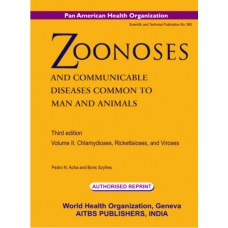Zoonoses and Communicable Diseases Common to Man and Animals, Vol. II
Zoonoses and Communicable Diseases Common to Man and Animals, Vol. II is backordered and will ship as soon as it is back in stock.
Couldn't load pickup availability
Genuine Products Guarantee
Genuine Products Guarantee
We guarantee 100% genuine products, and if proven otherwise, we will compensate you with 10 times the product's cost.
Delivery and Shipping
Delivery and Shipping
Products are generally ready for dispatch within 1 day and typically reach you in 3 to 5 days.
Book Details:
• Author: W.H.O.
• ISBN: 8174733108
• Publisher: World Health Organization (WHO)
• Edition: 3rd Edition
• Volume: II
• Language: English
• Binding: Hardcover
About the Book:
Volume II of Zoonoses and Communicable Diseases Common to Man and Animals delves into Chlamydioses, Rickettsioses, and Viroses—three critical categories of diseases that are transmitted between animals and humans. This volume is part of the comprehensive three-volume set, which covers the wide-ranging impacts of zoonotic diseases on public health and veterinary medicine.
Volume II specifically addresses:
• Chlamydioses: Infections caused by Chlamydia bacteria, which can lead to respiratory, ocular, and genital diseases.
• Rickettsioses: Diseases caused by Rickettsia bacteria, often transmitted through arthropod vectors like ticks and fleas, resulting in conditions like Rocky Mountain spotted fever.
• Viroses: A broad spectrum of viral infections, which can have significant health implications for humans, including diseases like rabies, hepatitis, and influenza.
The book is an indispensable resource for professors, students, and professionals in public health, veterinary medicine, and medicine, providing crucial information on these communicable diseases. It is designed to aid in the prevention, diagnosis, and management of zoonotic diseases that are a growing concern in both developing and industrialized countries.
This volume, along with the entire set, is essential for researchers, veterinarians, and health institutions, and contributes significantly to improving the collaboration between human and veterinary health professionals, thereby enhancing global disease control strategies.





